The Microsoft Surface Go LTE Review: Unmatched Mobility
by Brett Howse on January 17, 2019 8:00 AM ESTBattery Life
The Surface Go offers just a 27 Wh battery capacity, which is about half the size of a typical Ultrabook released in the last year. It’s also 40% smaller than the battery offered in the Surface Pro 6 which is the longest life Pro released yet. On the plus side, the smaller display has a lower pixel density, which should help, and the processor doesn’t offer any Turbo modes which would move the power draw of the CPU higher.
As with all of our battery testing, the display is set to 200 nits brightness, to provide an even playing field for all devices. We run several different tests of varying intensity with our 2016 Web test being the most demanding.
2013 Light Web

Our lightest test is our oldest, and the Surface Go isn’t off to a great start. At under eight hours on this test, the battery life is much less than a current generation Ultrabook, and well back of the latest model Surface Pro as well. A couple of years ago, this would have been reasonable battery life. In fact, the Surface Go almost matches the Surface Pro 3 in terms of runtime on this test, but the goal posts have definitely moved.
2016 Web
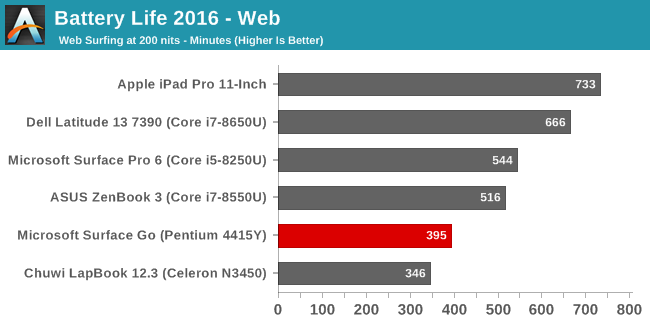
As with the previous test, the Surface Go struggles to keep up to the latest devices in this test as well. The Surface Pro 6 with a Core i5 offers 2.5 hours more battery life in this more demanding workload, which isn’t an insignificant amount of time. The tiny battery capacity hampers the Surface Go significantly here compared to other devices we’ve tested.
Movie Playback
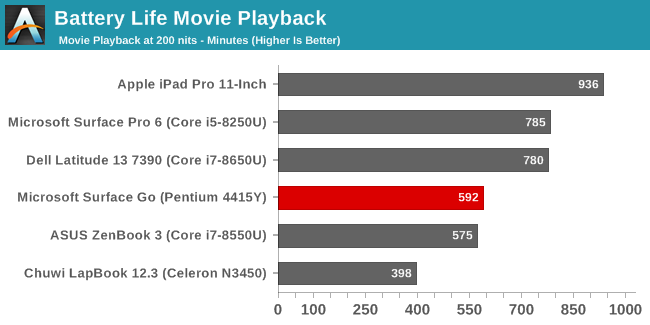
Movie playback is generally one of the best-case scenarios for modern devices since the media playback can be offloaded to the video decode unit, allowing the rest of the processor to go to sleep for much of the time. The Surface Go is still shy of the impressive results seen in the latest Surface Pro, but does get awfully near the 10-hour mark that Microsoft advertises for this device.
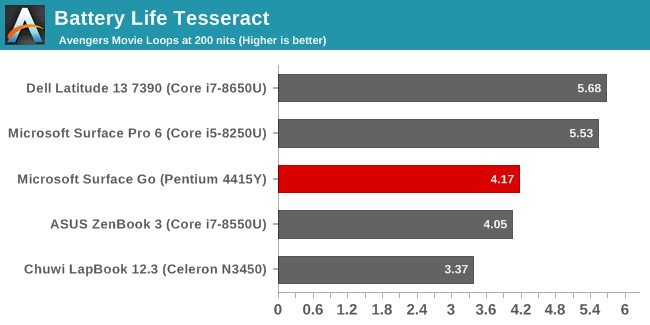
In terms of how many movies can you watch before the device runs out of juice, the Surface Go is pretty stout in this regard, with well over four runnings of The Avengers worth of battery life.
Normalized Results
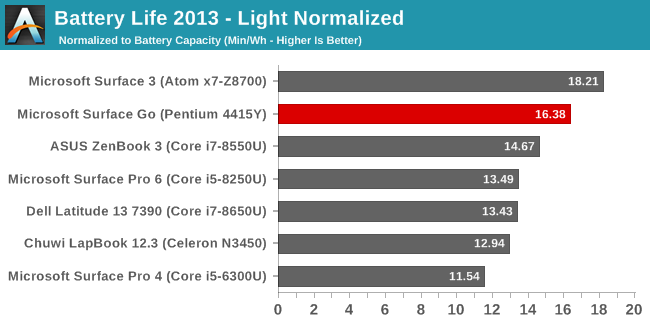
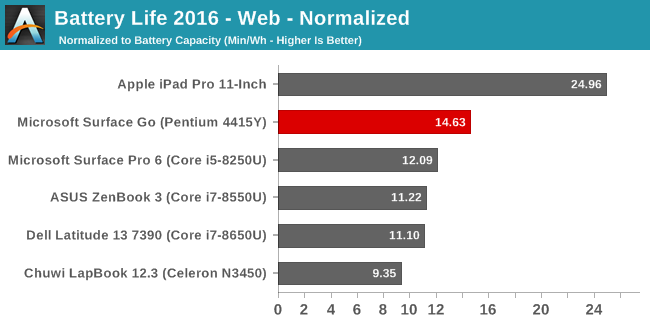
By removing the battery capacity from the equation, we can see how many minutes a device can last per Watt-Hour capacity of the battery. The Surface Go, mostly thanks to the display, does quite well in terms of efficiency. Put another way, on our 2016 Web test, the Surface Go averages 4.1 Watts of power draw with the display at 200 nits, and a Surface Pro 6 draws just a hair under 5 Watts during the same workload. So really, the less than amazing battery life really just comes down to not being able to fit more capacity in the Surface Go. The device is one of the most efficient we’ve tested.
Charge Time
The previous small form factor convertible tablet from Microsoft was the Surface 3, and it took a very long time to charge. Microsoft had outfitted it with a Micro USB port for charging, and then shipped it with just a 13 Watt AC adapter. It seems the company has learned its lesson there, and the Surface Go now offers the same Surface Connect port as the rest of the Surface lineup. It also ships with a 24 Watt adapter.
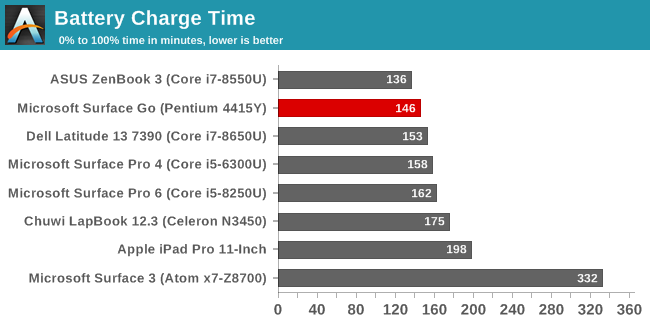
The result is a much better charge time than the Surface 3, and thanks to the smaller capacity battery, better than the Pro as well.
In addition, the Surface Go offers a USB-C port which will also do charging. This is a huge benefit for portable device such as this, since it would let you leave the main charger at home or work, and then use the same charger you use for your phone to top up the Surface Go. Microsoft seems to have an animosity towards USB-C, but this is the perfect device for them to offer it on.










79 Comments
View All Comments
thewishy - Thursday, January 17, 2019 - link
I've had a non-lte 8/128gb since November. I have a work Dell XPS 15, which is hugely powerful but has shockingly bad battery life and is utterly unsuited to use on a plane - so I have another machine to do heavy lifting.This machine gets used on work trips where I don't need much more than an RDP client to a lab, work, excel and OWA, and I want something to entertain me on long flights and evenings if I feel like.
It works brilliantly on the tray table in economy, the battery life might be "Poor", but with a 99wh USB-PD power pack the endurance of 16-24hrs. Given the cost and ease with which the life can be extended, 6hrs of browsing / word and 8-9 hours of movies without the power bank is reasonable IMHO. I wouldn't want to make it heavier for the sake of enhanced endurance. USB-PD charger allows me to charge phone, laptop and power bank with a single charger.
Performance is... slow. It's very noticeably less snappy than anything else I use, but doesn't crawl to a halt under load (For example, no problems with it swapping out). Under light use it's fine, and it works fine for light games.
Screen is sharp, a mouse transforms usability for office use. Keyboard is ok after a short adjustment period, but the trackpad can get in the way occasionally.
Bezel is a little large, but does make it easy to hand hold.
Lack of USB-A is a bit of a pain if you have a Yubikey, and a second USB-C would be lovely if you're using that for charging.
As my only machine it would drive me nuts, but for a specific use case it's been perfect.
TheinsanegamerN - Saturday, January 19, 2019 - link
The interior design of the Go is pathetic for battery packaging. You wouldnt have to make it thicker to fit more battery in there.Trefugl - Thursday, January 17, 2019 - link
Any idea how the CPU performance compares to the original Surface Pro (16:9 one)? I have one of those that I still use for travel, but it's definitely showing its age and the pen input isn't nearly as good as modern surface tablets, and the screens are nearly as nice either... Ideally I'm hoping that I could do some light editing of raw photos in lightroom while on the go, even if it's mildly painful... still better than trying to do it on my phone or carrying around something much bigger.Brett Howse - Thursday, January 17, 2019 - link
Hi Trefugl. I'll reference you to our Online Bench which was also linked in the article:https://www.anandtech.com/bench/product/1207?vs=23...
HStewart - Saturday, January 19, 2019 - link
I also have original Surface Pro and rarely use it - even though it performance is around i7 Y CPU.A good link to compare cpus is the following
https://cpu.userbenchmark.com/Compare/Intel-Pentiu...
It going to be really interesting to see Lakefield - it will like beat the Surface Pro 1 cpu in performance and have extreme battery life - this will be perfect for LTE companion
HStewart - Saturday, January 19, 2019 - link
Computer performance changes over time - I did use my Surface Pro 1 for photoshop and even Lightwave - but new CPU's today make a big difference.eastcoast_pete - Thursday, January 17, 2019 - link
Interesting device, somewhat overpriced. I really wish MS would go further on the mobility aspect and provide a significantly (50% bigger) larger battery. Even with 100 g more weight, it would still be light enough to carry around. Always connected shouldn't mean being plugged into an outlet after just a few hours.tmanini - Thursday, January 17, 2019 - link
"Microsoft also color calibrates all of its displays"I didn't find a handy reference article for this, so I can't confirm the statement or what exactly is done. But even if they do 'something' before it is boxed up, that calibration will drift in short order and essentially become useless. (if you plan to rely on it)
melgross - Thursday, January 17, 2019 - link
That’s not true. It used to be true in the days of the crt, but not now. Apple also calibrates all of its displays, including those in the iMac, and it’s pretty stable. That doesn’t mean that several years later it’s still perfect, but it’s pretty close, even then.The thing about these though, is that they’re just sRGB, which isn’t saying much these days.
anactoraaron - Thursday, January 17, 2019 - link
Exactly this. What exactly is the point of having a calibrated accurate display for maybe 1 month? Panels drift the most in the first year.The other thing that happens not just here at AT is these notebooks and tablets being touted as 'for image and video professionals' just because the display is accurate out of the box. This needs to stop.
Any system that lacks a display osd/hardware rgb channel/brightness/contrast adjustment isn't suited for any professional. Software can only do so much (making adjustments through Intel graphics software is awful) and for folks that absolutely need color accuracy (longer than 1 month out of the box) need the ability to adjust color channels, brightness, and contrast at the hardware level. I had a surface pro, and over time software couldn't properly calibrate it anymore. Sold it recently and went back to desktop, mobility be damned.